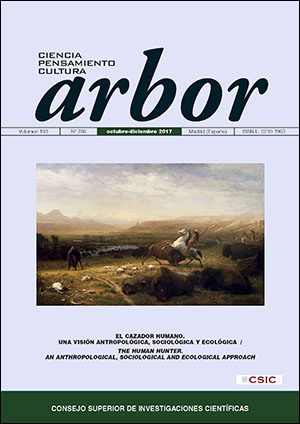Hunting in the Upper Paleolithic: key concepts of economic anthropology applied to the Iberian Peninsula
DOI:
https://doi.org/10.3989/arbor.2017.786n4001Keywords:
Hunting, Iberian region, paleoeconomy, Upper PalaeolithicAbstract
Paleoeconomic research carried out in recent years into Upper Palaeolithic hunting in the Iberian Peninsula would have been impossible without the important contribution of the American Anthropology School. This paper summarizes the history of this research, and the main landmarks in the evolution of hunting strategies and the theoretical context of the principal hypotheses.
Downloads
References
Altuna, J. (1972). Fauna de mamíferos de los yacimientos prehistóricos de Guipúzcoa. Con catálogo de los mamíferos cuaternarios del Cantábrico y del Pirineo Occidental. San Sebastián: Sociedad de Ciencias Naturales Aranzadi. Disponible en http://www.rhinoresourcecenter.com/ pdf_files/129/1293849734.pdf?view y en http://www.rhinoresourcecenter.com/ pdf_files/129/1293849925.pdf?view
Arias Cabal, P. (1991). De cazadores a campesinos. La transición al neolítico en la región cantábrica. Santander: Universidad de Cantabria / Asamblea Regional de Cantabria.
Binford, L. R. (1980). Willow Smoke and Dogs' Tails: Hunther-Gatherer Settlement Systems and Archaeological Site Formation. American Antiquity, 45 (1), pp. 4-20. https://doi.org/10.2307/279653
Butzer, K. W. (1989). Arqueología, una ecología del hombre. Método y teoría para un enfoque contextual. Barcelona: Bellaterra.
Clark, G. y Yi, S. (1983). Niche-width variation in Cantabrian archaeofaunas: a diachronic study. En: Grigson, C. y Clutton-Brock, J. (eds.). Animals and archaeology (volume I. Hunters and their prey). Oxford: British Archaeological Reports, pp. 183-208.
Cohen, M. N. (1981). La crisis alimentaria de la prehistoria. La superpoblación y los orígenes de la agricultura. Madrid: Alianza.
Davidson, I. (1989). La economía del final del Paleolítico en la Espa-a oriental. Valencia: Diputación Provincial de Valencia. Servicio de Investigación Prehistórica.
Estévez, J. (2005). Catástrofes en la Prehistoria. Barcelona: Bellaterra.
Freeman, L. G. (1973). The Significance of Mammalian Faunas from Paleolithic Occupations in Cantabrian Spain. American Antiquity 38 (1), pp. 3-44. https://doi.org/10.2307/279309
González Sainz, C. (1989). El Magdaleniense Superior Final de la región cantábrica. [Tesis doctoral inédita]. Universidad de Cantabria: Santander. Disponible en http://www.tdx.cat/bitstream/ handle/10803/22651/0de8.CGSprevio_ capI_capII.pdf;jsessionid=E62ED1C6C5DB 9CE0CC9D44D257E38DFA?sequence=1
Harris, D. R. (1978). Settling Down: An Evolutionary Model for the Transformation of Mobile Bands into Sedentary Communities. En: Friedman, J. y Rowlands, M. J. (eds.). The Evolution of Social Systems. Proceedings of a Meeting of the Research Seminar in Archaeology and Related Subjects, held at the Institute of Archaeology, London University. Pittsburgh: University of Pittsburgh Press, pp. 401-417.
Quesada, J. M. (1998a). La caza en la Prehistoria. Madrid: Arco Libros.
Quesada, J. M. (1998b). Los cazadores-recolectores cantábricos del Inter Laugerie-Lascaux. Complutum, 8, pp. 7-32.
Ramos, J. (1999): Europa prehistórica. Cazadores y recolectores. Madrid: Sílex.
Rasilla Vives, M. de la y Straus, L. G. (2004). El poblamiento en la región cantábrica en torno al Último Máximo Glacial: Gravetiense y Solutrense. En: Fano, M. A. (coord.). Las Sociedades del Paleolítico en la Región Cantábrica. Kobie, 8, pp. 209-244.
Straus, L. G. (1977). Of deerslayers and mountain men: Paleolithic faunal explotaition in Cantabrian Spain. En: Binford, L. R. (ed.). For Theory Building in Archaeology. Essays on faunal remains, aquatic resources, spatial analysis, and systemic modeling. Nueva York: Academic Press, pp. 41-76.
Straus, L. G. (1983). El solutrense vasco-cantábrico. Una nueva perspectiva. Madrid: Ministerio de Educación, Cultura y Deporte.
Published
How to Cite
Issue
Section
License
Copyright (c) 2018 Consejo Superior de Investigaciones Científicas (CSIC)

This work is licensed under a Creative Commons Attribution 4.0 International License.
© CSIC. Manuscripts published in both the printed and online versions of this Journal are the property of Consejo Superior de Investigaciones Científicas, and quoting this source is a requirement for any partial or full reproduction.
All contents of this electronic edition, except where otherwise noted, are distributed under a “Creative Commons Attribution 4.0 International” (CC BY 4.0) License. You may read the basic information and the legal text of the license. The indication of the CC BY 4.0 License must be expressly stated in this way when necessary.
Self-archiving in repositories, personal webpages or similar, of any version other than the published by the Editor, is not allowed.














